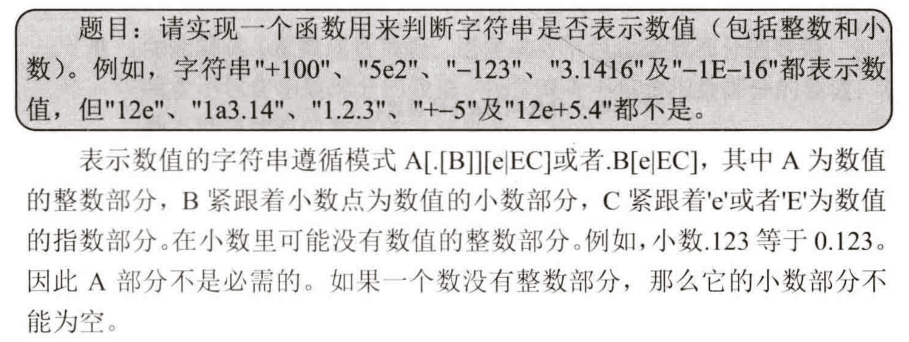摘自-剑指OFFER


/******************************************************************* Copyright(c) 2016, Harry He All rights reserved. Distributed under the BSD license. (See accompanying file LICENSE.txt at https://github.com/zhedahht/CodingInterviewChinese2/blob/master/LICENSE.txt) *******************************************************************/ //================================================================== // 《剑指Offer——名企面试官精讲典型编程题》代码 // 作者:何海涛 //================================================================== // 面试题20:表示数值的字符串 // 题目:请实现一个函数用来判断字符串是否表示数值(包括整数和小数)。例如, // 字符串“+100”、“5e2”、“-123”、“3.1416”及“-1E-16”都表示数值,但“12e”、 // “1a3.14”、“1.2.3”、“+-5”及“12e+5.4”都不是 #include <stdio.h> bool scanUnsignedInteger(const char** str); bool scanInteger(const char** str); // 数字的格式可以用A[.[B]][e|EC]或者.B[e|EC]表示,其中A和C都是 // 整数(可以有正负号,也可以没有),而B是一个无符号整数 bool isNumeric(const char* str) { if (str == nullptr) return false; bool numeric = scanInteger(&str); // 如果出现'.',接下来是数字的小数部分 if (*str == '.') { ++str; // 下面一行代码用||的原因: // 1. 小数可以没有整数部分,例如.123等于0.123; // 2. 小数点后面可以没有数字,例如233.等于233.0; // 3. 当然小数点前面和后面可以有数字,例如233.666 numeric = scanUnsignedInteger(&str) || numeric; } // 如果出现'e'或者'E',接下来跟着的是数字的指数部分 if (*str == 'e' || *str == 'E') { ++str; // 下面一行代码用&&的原因: // 1. 当e或E前面没有数字时,整个字符串不能表示数字,例如.e1、e1; // 2. 当e或E后面没有整数时,整个字符串不能表示数字,例如12e、12e+5.4 numeric = numeric && scanInteger(&str); } return numeric && *str == '�'; } bool scanUnsignedInteger(const char** str) { const char* before = *str; while (**str != '�' && **str >= '0' && **str <= '9') ++(*str); // 当str中存在若干0-9的数字时,返回true return *str > before; } // 整数的格式可以用[+|-]B表示, 其中B为无符号整数 bool scanInteger(const char** str) { if (**str == '+' || **str == '-') ++(*str); return scanUnsignedInteger(str); } // ====================测试代码==================== void Test(const char* testName, const char* str, bool expected) { if (testName != nullptr) printf("%s begins: ", testName); if (isNumeric(str) == expected) printf("Passed. "); else printf("FAILED. "); } int main(int argc, char* argv[]) { Test("Test1", "100", true); Test("Test2", "123.45e+6", true); Test("Test3", "+500", true); Test("Test4", "5e2", true); Test("Test5", "3.1416", true); Test("Test6", "600.", true); Test("Test7", "-.123", true); Test("Test8", "-1E-16", true); Test("Test9", "1.79769313486232E+308", true); printf(" "); Test("Test10", "12e", false); Test("Test11", "1a3.14", false); Test("Test12", "1+23", false); Test("Test13", "1.2.3", false); Test("Test14", "+-5", false); Test("Test15", "12e+5.4", false); Test("Test16", ".", false); Test("Test17", ".e1", false); Test("Test18", "e1", false); Test("Test19", "+.", false); Test("Test20", "", false); Test("Test21", nullptr, false); return 0; }
